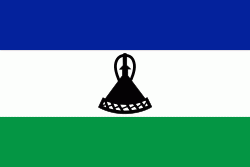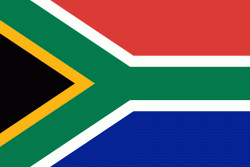Zulu language
Zulu, or isiZulu as an endonym, is a Southern Bantu language of the Nguni branch spoken in Southern Africa. It is the language of the Zulu people, with about 12 million native speakers, who primarily inhabit the province of KwaZulu-Natal of South Africa. Zulu is the most widely spoken home language in South Africa (24% of the population), and it is understood by over 50% of its population. It became one of South Africa's 11 official languages in 1994.
According to Ethnologue, it is the second-most-widely spoken of the Bantu languages, after Swahili. Like many other Bantu languages, it is written with the Latin alphabet.
In South African English, the language is often referred to in its native form, isiZulu.
The Zulu, like Xhosa and other Nguni people, have lived in South Africa for a long time. The Zulu language possesses several click sounds typical of Southern African languages, not found in the rest of Africa. The Nguni people have coexisted with other Southern tribes like the San and Khoi.
Zulu, like most indigenous Southern African languages, was not a written language until the arrival of missionaries from Europe, who documented the language using the Latin script. The first grammar book of the Zulu language was published in Norway in 1850 by the Norwegian missionary Hans Schreuder. The first written document in Zulu was a Bible translation that appeared in 1883. In 1901, John Dube (1871–1946), a Zulu from Natal, created the Ohlange Institute, the first native educational institution in South Africa. He was also the author of Insila kaShaka, the first novel written in Zulu (1930). Another pioneering Zulu writer was Reginald Dhlomo, author of several historical novels of the 19th-century leaders of the Zulu nation: U-Dingane (1936), U-Shaka (1937), U-Mpande (1938), U-Cetshwayo (1952) and U-Dinizulu (1968). Other notable contributors to Zulu literature include Benedict Wallet Vilakazi and, more recently, Oswald Mbuyiseni Mtshali.
The written form of Zulu was controlled by the Zulu Language Board of KwaZulu-Natal. This board has now been disbanded and superseded by the Pan South African Language Board which promotes the use of all eleven official languages of South Africa.
According to Ethnologue, it is the second-most-widely spoken of the Bantu languages, after Swahili. Like many other Bantu languages, it is written with the Latin alphabet.
In South African English, the language is often referred to in its native form, isiZulu.
The Zulu, like Xhosa and other Nguni people, have lived in South Africa for a long time. The Zulu language possesses several click sounds typical of Southern African languages, not found in the rest of Africa. The Nguni people have coexisted with other Southern tribes like the San and Khoi.
Zulu, like most indigenous Southern African languages, was not a written language until the arrival of missionaries from Europe, who documented the language using the Latin script. The first grammar book of the Zulu language was published in Norway in 1850 by the Norwegian missionary Hans Schreuder. The first written document in Zulu was a Bible translation that appeared in 1883. In 1901, John Dube (1871–1946), a Zulu from Natal, created the Ohlange Institute, the first native educational institution in South Africa. He was also the author of Insila kaShaka, the first novel written in Zulu (1930). Another pioneering Zulu writer was Reginald Dhlomo, author of several historical novels of the 19th-century leaders of the Zulu nation: U-Dingane (1936), U-Shaka (1937), U-Mpande (1938), U-Cetshwayo (1952) and U-Dinizulu (1968). Other notable contributors to Zulu literature include Benedict Wallet Vilakazi and, more recently, Oswald Mbuyiseni Mtshali.
The written form of Zulu was controlled by the Zulu Language Board of KwaZulu-Natal. This board has now been disbanded and superseded by the Pan South African Language Board which promotes the use of all eleven official languages of South Africa.
Country
-
Lesotho
Lesotho, officially the Kingdom of Lesotho, is a country landlocked as an enclave in South Africa. It is situated in the Maloti Mountains and contains the highest mountains in Southern Africa. It has an area of over 30000 km2 and has a population of about million.
It was previously the British Crown colony of Basutoland, which was given independence by the United Kingdom on 4 October 1966. It is a fully sovereign state and is a member of the United Nations, the Commonwealth of Nations, the African Union, and the Southern African Development Community. The name Lesotho roughly translates to "land of the Sotho". -
South Africa
South Africa, officially the Republic of South Africa (RSA), is the southernmost country in Africa. It is bounded to the south by 2798 km of coastline that stretch along the South Atlantic and Indian Oceans; to the north by the neighbouring countries of Namibia, Botswana, and Zimbabwe; and to the east and northeast by Mozambique and Eswatini. It also completely enclaves the country Lesotho. It is the southernmost country on the mainland of the Old World, and the second-most populous country located entirely south of the equator, after Tanzania. South Africa is a biodiversity hotspot, with unique biomes, plant and animal life. With over 60 million people, the country is the world's 24th-most populous nation and covers an area of 1221037 km2. South Africa has three capital cities, with the executive, judicial and legislative branches of government based in Pretoria, Bloemfontein, and Cape Town respectively. The largest city is Johannesburg.
About 80% of the population are Black South Africans. The remaining population consists of Africa's largest communities of European (White South Africans), Asian (Indian South Africans and Chinese South Africans), and multiracial (Coloured South Africans) ancestry. South Africa is a multiethnic society encompassing a wide variety of cultures, languages, and religions. Its pluralistic makeup is reflected in the constitution's recognition of 11 official languages, the fourth-highest number in the world. According to the 2011 census, the two most spoken first languages are Zulu (22.7%) and Xhosa (16.0%). The two next ones are of European origin: Afrikaans (13.5%) developed from Dutch and serves as the first language of most Coloured and White South Africans; English (9.6%) reflects the legacy of British colonialism and is commonly used in public and commercial life.
